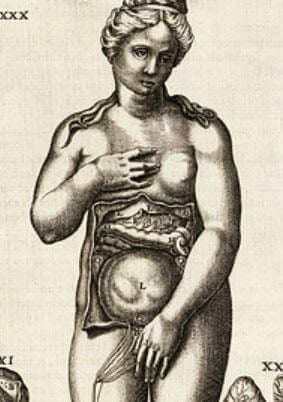In the days before intellectual property laws (and when plagiarism was sometimes viewed as a compliment to the author) Juan Valverde of Spain wrote a book on anatomy so successful that it went through sixteen editions in four languages and its illustrations remain popular to this day.
It was composed in 1556 and titled Anatomia del corpo umano. At least some of the drawings were made by the Spanish artist Gaspar Becerra and some of the copper engravings by the reputed engraver Nicolas Beatrizet from Lorraine. Of its forty-two plates Valdeverde composed fifteen and copied (but often altered) most others from Vesalius, saying he admired him greatly but used his illustrations to avoid confusion. Vesalius did not appreciate having his work copied, calling Valdeverde an ignoramus who did not know medicine, had done few dissections himself, and only published in Spanish to make a shameful profit.
The work nevertheless was pleasing and instructive as well as amusing. Most of the skeletons had been playfully altered, shown not rigid in death but lively in various positions. One is famously shown holding up its own skin. Others are wearing Roman armor plates; holding a skull in their hands; displaying their uterus and pancreas through a hole in the abdominal wall; or prudishly covering sensitive areas with bony hands. Importantly, some mistakes made by Vesalius were corrected.
The author, Juan Valdeverde, was born in Spain and moved in 1542 to Italy, studying in Padua and Rome. He then practiced medicine in Rome until his death, never returning to his intellectually reactionary native country. In his studies he described the skeleton in detail, especially the bones of the face, their nerves and blood supply; the muscles of movement of the eye, nose, and larynx; the middle ear and the anatomy of the stapes; and the intracranial course of the carotid artery. His book remains popular, his plates often shown, and he is regarded as having made significant contribution to the science of anatomy. He is particularly lauded by his proud compatriots in Spain.





Leave a Reply